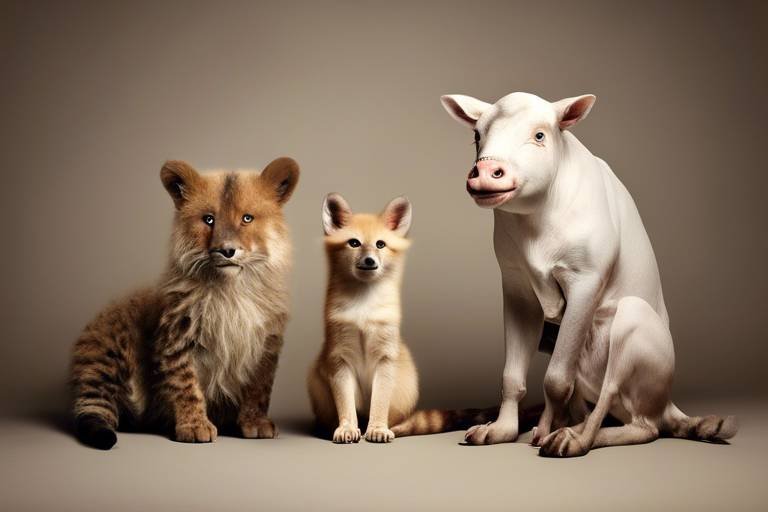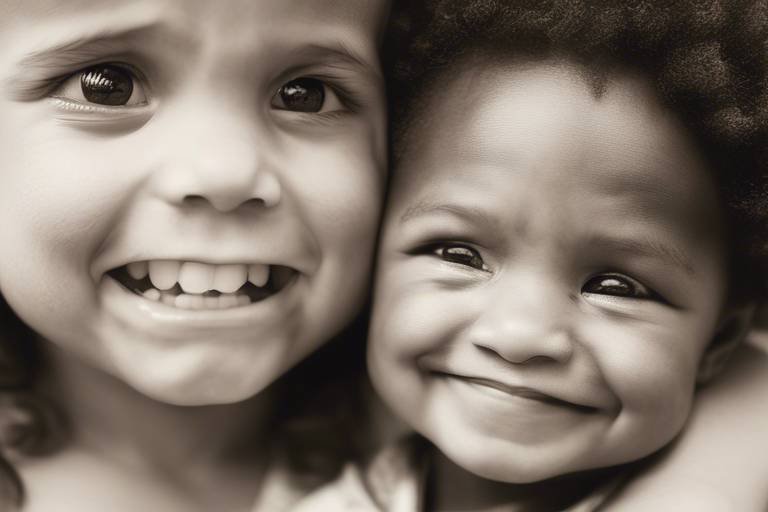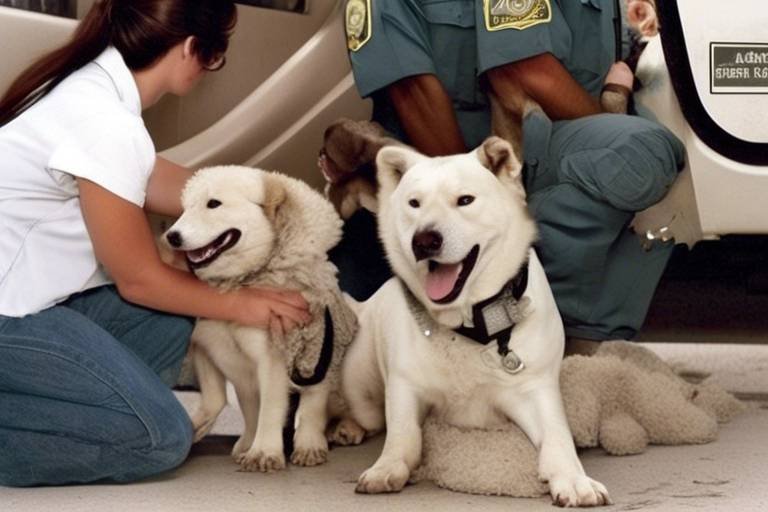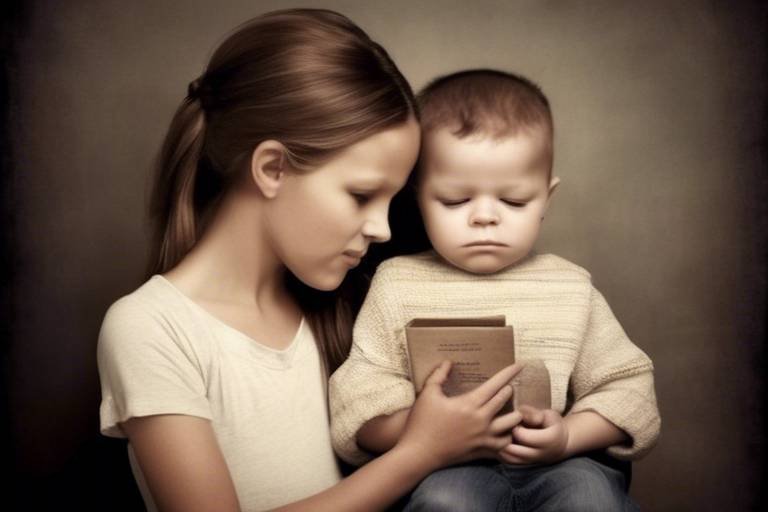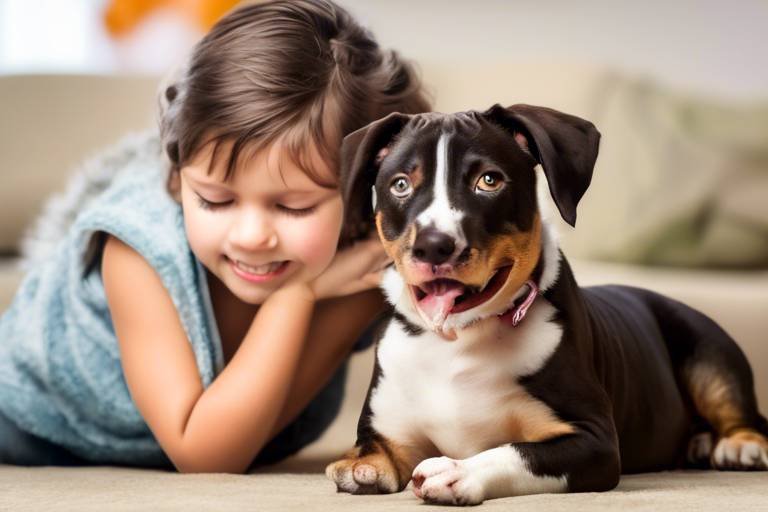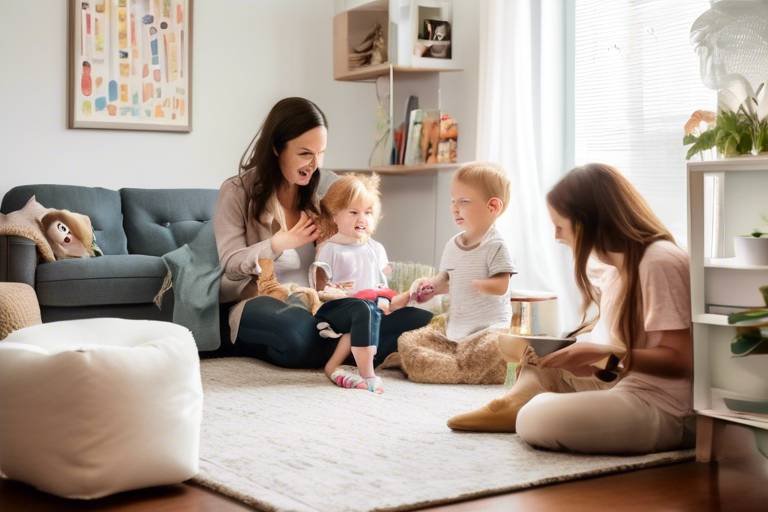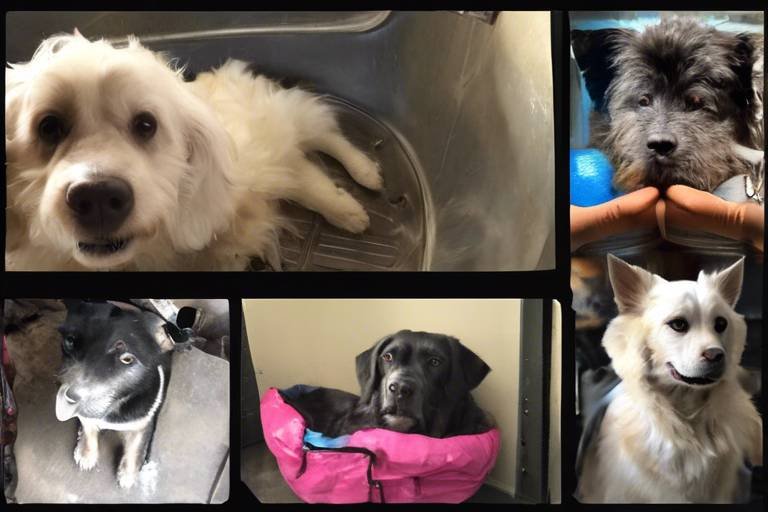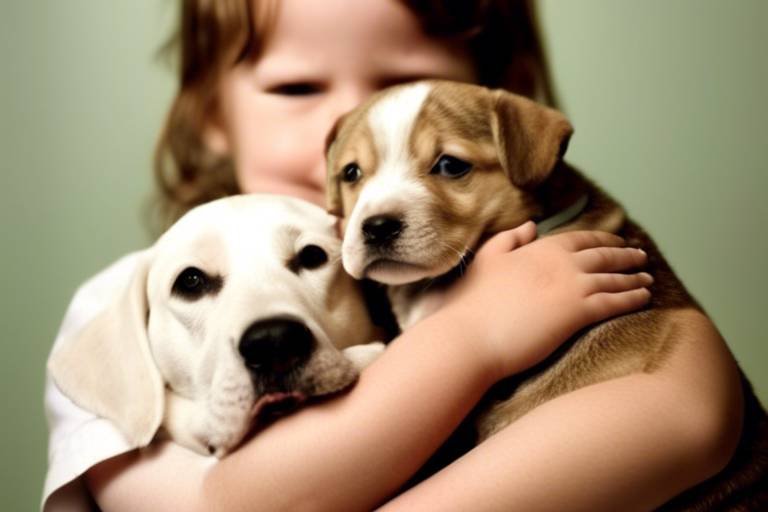The Benefits of Pet Adoption for Families with Kids
Adopting a pet is not just about bringing home a furry friend; it's about enriching the lives of your entire family, especially your kids. Imagine the joy of watching your children bond with a new puppy or kitten, their faces lighting up with laughter and love. The benefits of pet adoption for families with kids are profound and multifaceted, encompassing emotional, social, and educational dimensions. Not only do pets offer companionship and unconditional love, but they also provide a unique opportunity for children to learn valuable life skills. In this article, we'll explore these benefits in detail and share tips on how to make the transition to pet ownership as smooth as possible.
One of the most significant advantages of adopting a pet is the emotional boost it provides to children. Pets are known to offer unwavering companionship, which can be a source of comfort during challenging times. The simple act of petting a dog or cat can reduce stress and anxiety levels, creating a calming environment for your little ones. As children care for their pets, they also experience a sense of responsibility that fosters maturity. This responsibility can lead to a deeper understanding of empathy, as kids learn to recognize and respond to the needs of their furry companions. Think of it as nurturing their emotional intelligence—it's like planting seeds of compassion that will grow as they mature.
Having a pet can be a game-changer when it comes to developing social skills in children. Pets naturally encourage interaction, not only between the child and the pet but also among family members and friends. For instance, when kids walk their dogs in the neighborhood, they often meet other pet owners, sparking conversations and friendships. This social engagement helps children hone their communication skills and learn the importance of teamwork. A pet can be the common thread that weaves friendships together, creating a supportive network for your child. It's like having a furry icebreaker that opens doors to new connections!
Pets can serve as a fantastic common interest among children, helping them forge friendships with peers who share a love for animals. These shared passions can lead to deeper connections, as kids bond over their experiences and stories related to their pets. Imagine a group of children excitedly discussing their favorite dog breeds or the funniest things their cats have done. This shared enthusiasm not only enhances their social circles but also instills a sense of belonging and community.
Engaging in group activities with pets, such as dog walking or participating in training sessions, promotes teamwork and cooperation among children. These activities encourage kids to work together, fostering stronger bonds and friendships through shared experiences. Whether it's organizing a neighborhood pet parade or collaborating on training tricks, these moments create lasting memories and teach children the value of collaboration.
Caring for a pet also teaches children to understand and respond to the needs of others. This nurturing process is crucial in developing their ability to empathize. For instance, when a child learns to recognize when their pet is hungry or tired, they are also learning to be more attentive to the feelings of others, both human and animal. It's like giving them a front-row seat to the beauty of compassion and kindness, reinforcing the importance of caring for those around them.
Having a pet encourages families to spend quality time together, strengthening family bonds through shared responsibilities and activities. Whether it's feeding the pet, playing fetch at the park, or simply cuddling on the couch, these moments create a sense of unity and togetherness. Imagine a family game night where everyone gets involved in a fun training session with their dog—it's a recipe for laughter and cherished memories!
Pet adoption can also provide children with valuable learning experiences that extend beyond the emotional and social realms. As they take on the responsibility of caring for a pet, they gain insights into animal care, responsibility, and the importance of compassion towards living beings. It's like a hands-on lesson in life skills that will serve them well into adulthood.
Children learn about the daily needs of pets, including feeding, grooming, and exercise. This knowledge instills a sense of responsibility and commitment to caring for another living creature. By understanding what it takes to keep a pet healthy and happy, kids develop a strong sense of accountability. It's a fantastic way to teach them that love is not just a feeling but also an action that requires effort.
Taking care of a pet helps children grasp important life lessons about responsibility, commitment, and the consequences of their actions. For instance, if a child forgets to feed their pet, they quickly learn that neglect can lead to unhappy animals. This understanding prepares them for future challenges and teaches them that their actions have real-world implications. It's like a mini-training ground for adulthood, where they can learn and grow in a safe environment.
- What type of pet is best for families with kids? Consider pets that are known for their gentle and friendly nature, such as dogs, cats, or even guinea pigs.
- How can I prepare my child for pet ownership? Educate them about the responsibilities involved, and involve them in the adoption process to foster excitement and commitment.
- Can pets help with my child's anxiety? Yes, pets can provide comfort and companionship, which can significantly reduce anxiety levels in children.

Emotional Benefits of Pet Adoption
Adopting a pet is not just about bringing a furry friend into your home; it’s about enriching the emotional landscape of your family, especially for children. Imagine a child coming home from school, their face lighting up at the sight of a wagging tail or a gentle purr. This simple act of companionship can significantly enhance a child's emotional well-being. Pets offer unconditional love and companionship, which can be especially comforting during tough times. They become a source of joy, laughter, and a sense of security that every child craves.
Moreover, having a pet teaches children responsibility. When kids are given the task of feeding, grooming, or walking their pet, they learn to care for another living being. This sense of responsibility fosters maturity and helps them develop important life skills. It’s like nurturing a tiny piece of the world; they learn that their actions have consequences, and this understanding can lead to a more empathetic approach to others, including their peers and family members.
Additionally, the emotional bond formed between children and their pets can lead to increased empathy. When kids learn to recognize when their pet is happy, sad, or in need of care, they develop a deeper understanding of emotions, not just in animals but in humans too. This ability to connect emotionally with others is a vital skill that will serve them throughout their lives.
To illustrate the emotional benefits of pet adoption, consider this: a study conducted by the American Psychological Association found that children with pets tend to have lower levels of anxiety and depression. The presence of a pet can act as a calming influence, providing a sense of stability and comfort. This is particularly beneficial in today’s fast-paced world where children often face various pressures.
Furthermore, pets can help children express their feelings. When kids are upset or stressed, they often find it easier to talk to their pets than to adults. This unique bond can provide a safe space for children to process their emotions, leading to improved mental health and resilience. In essence, pets become a therapeutic outlet, allowing children to navigate their feelings in a healthy way.
In summary, the emotional benefits of pet adoption extend far beyond simple companionship. They foster responsibility, empathy, and emotional intelligence, equipping children with valuable life skills that will last a lifetime. Adopting a pet is, without a doubt, a profound step towards nurturing well-rounded, emotionally intelligent individuals.

Social Skills Development
When we think about the impact of pets on children, one of the most remarkable aspects is how they can significantly enhance social skills. Imagine a child, initially shy and reserved, suddenly blossoming into a more confident individual, all thanks to the furry friend by their side. Pets serve as a bridge to social interactions, encouraging kids to engage not only with their pets but also with their peers and family members. This interaction fosters essential skills such as communication, teamwork, and empathy.
Pets can be fantastic conversation starters. Have you ever noticed how a cute puppy or a playful kitten can draw a crowd? Children often find it easier to talk about their pets, sharing stories or experiences that can lead to deeper conversations with friends. This not only helps them practice their verbal skills but also teaches them how to express their feelings and thoughts in a safe environment.
Moreover, caring for a pet can instill a sense of teamwork among siblings or friends. For instance, when a family adopts a dog, everyone can pitch in to help with feeding, walking, and grooming. These shared responsibilities create an atmosphere of collaboration and teach children how to work together towards a common goal. Just like in a sports team, where each player has a role to play, every family member can contribute to the well-being of their pet, strengthening their bonds in the process.
Pets can also serve as a common interest, helping children forge friendships with peers who share a love for animals. Think about it: when children meet at the dog park or during a pet training class, they instantly have something to talk about. This shared enthusiasm can lead to lasting friendships, as they bond over their experiences and stories involving their beloved pets.
Engaging in group activities, such as dog walking or participating in pet training sessions, not only promotes teamwork but also provides opportunities for children to make new friends. These activities encourage cooperation among children, fostering stronger bonds and friendships through shared experiences. Just imagine a group of kids walking their dogs together, laughing and sharing tips on how to train their pets. It’s a perfect recipe for building social connections!
Caring for a pet teaches children to understand and respond to the needs of others, nurturing their ability to empathize and connect with both animals and people. When children learn to recognize when their pet is hungry, tired, or in need of attention, they are also learning to be more attuned to the feelings of those around them. This heightened sense of empathy can translate into their interactions with friends and family, making them more compassionate individuals.
In conclusion, adopting a pet can be a transformative experience for children, providing them with invaluable lessons in social skills. From building friendships through shared interests to developing empathy through care, pets play a crucial role in shaping a child’s social landscape. So, if you’re considering bringing a furry friend into your home, know that you’re not just gaining a pet; you’re also enriching your child’s life in ways that will last a lifetime.
- What age is appropriate for a child to have a pet?
While it varies by family, many experts suggest that children aged 5 and up can start taking on pet responsibilities with adult supervision. - What type of pet is best for a family with kids?
Family-friendly pets include dogs, cats, and even small animals like guinea pigs or rabbits, depending on the family's lifestyle. - How can I ensure my child is responsible for their pet?
Start with small tasks and gradually increase responsibilities as they show they can handle them. Consistent routines are key! - What if my child is allergic to pets?
Consider hypoallergenic breeds or consult with an allergist to explore options that could work for your family.
Building Friendships
When it comes to building friendships, pets can be the ultimate icebreakers. Imagine a child taking their dog for a walk in the neighborhood; it's not just a stroll, but a golden opportunity to connect with other kids. As they walk, they might encounter another child with a similar furry friend. Suddenly, a conversation sparks, and just like that, a new friendship is born! Pets have this magical ability to create common ground among children, allowing them to bond over shared interests and experiences.
Furthermore, having a pet can encourage children to participate in community activities, such as dog parks or pet adoption events. These social gatherings provide a fantastic platform for kids to meet others who share their passion for animals. They can engage in conversations, share stories about their pets, and even participate in group activities. This not only enhances their social skills but also helps them develop a sense of belonging within their community.
Pets can also serve as a source of comfort during challenging social interactions. For instance, shy children may find it easier to approach others when they have a pet by their side. The presence of a furry companion can ease anxiety and make socializing feel less intimidating. In this way, pets act as social catalysts, helping children break out of their shells and engage with their peers more confidently.
Moreover, caring for a pet can teach children valuable lessons about teamwork and cooperation. When families involve their children in pet care—whether it's feeding, grooming, or training—children learn to work together towards a common goal. This shared responsibility fosters a sense of unity and encourages them to communicate effectively with one another. It's like being part of a little team, where everyone has a role to play, and the reward is the love and joy that their pet brings into their lives.
In essence, pets are not just companions; they are bridges to friendships. They help children connect with others, teach them the importance of teamwork, and provide them with the confidence to engage socially. So, if you're considering adding a furry friend to your family, remember that you’re not just adopting a pet; you’re also opening up a world of social opportunities for your children!
- How can pets help my child make friends? Pets can serve as conversation starters and provide common ground for children to bond over shared interests.
- What types of activities can my child do with their pet to meet other kids? Activities like visiting dog parks, participating in pet training classes, or joining community pet events can help children meet peers.
- Can pets help shy children socialize? Yes, pets can provide comfort and confidence for shy children, making it easier for them to approach and interact with others.
Group Activities with Pets
Engaging in not only promotes physical health but also fosters emotional and social growth among children. Imagine a sunny Saturday morning where your family, along with friends, gathers at a local park for a fun-filled day with their furry companions. Activities like dog walking, training sessions, or even participating in pet-friendly community events can turn into memorable bonding experiences. These activities encourage teamwork and cooperation, as kids learn to work together to manage their pets, whether it’s teaching them new tricks or organizing a playful game of fetch.
Moreover, these group interactions can serve as a perfect backdrop for developing essential life skills. For instance, when children are involved in a group dog training session, they learn to communicate effectively, not just with their pets but also with their peers. They practice patience and understanding, realizing that every pet learns at its own pace. This shared experience can help children build friendships based on common interests, creating a support network that extends beyond the love of animals.
Consider the joy of organizing a neighborhood pet parade. Children can collaborate to plan the event, decorate their pets, and even create fun costumes. Such activities not only enhance their creativity but also instill a sense of responsibility as they look after their pets throughout the event. The excitement of showcasing their beloved animals can lead to conversations and connections with other pet-loving families, enriching their social lives.
In addition to enhancing social interactions, these group activities can also teach children valuable lessons about empathy and compassion. As they care for their pets alongside friends, they learn to recognize and respond to the needs of others—both human and animal. This nurturing aspect of pet care can lead to deeper emotional connections, helping children develop a greater understanding of the feelings and needs of those around them.
Ultimately, group activities with pets create a unique environment where children can thrive socially and emotionally. The laughter, teamwork, and shared responsibilities not only strengthen family bonds but also lay the groundwork for lifelong friendships and valuable life lessons. So, gather your friends, grab those leashes, and let the adventures with your furry friends begin!
- What are some fun group activities I can do with my pet?
Some fun activities include dog walking clubs, pet training sessions, and community pet parades. These events allow for socialization and teamwork while enjoying time with your furry friends.
- How can group activities help my child develop social skills?
Group activities encourage children to communicate, cooperate, and empathize with others, helping them build stronger relationships and enhance their social skills.
- Are there any safety concerns with group activities for pets?
Yes, it’s essential to ensure that all pets are well-socialized and vaccinated. Always supervise interactions between pets and children to ensure a safe environment.
Encouraging Empathy
Adopting a pet is not just about bringing home a furry friend; it’s about nurturing a sense of empathy in children that can last a lifetime. When kids take on the responsibility of caring for a pet, they begin to understand the feelings and needs of another living being. This journey of caring for an animal teaches them to be attuned to emotions, both their own and those of others. For instance, when a dog wags its tail or a cat purrs, children learn to recognize these signals as signs of happiness or contentment. Conversely, when a pet is feeling unwell or anxious, kids become aware of the importance of responding with care and compassion.
Moreover, the act of nurturing a pet can be a profound way to instill a sense of responsibility. Children learn that pets depend on them for food, shelter, and love. This dependency fosters a bond that encourages kids to think beyond themselves, cultivating a natural instinct to care for others. As they engage in activities like feeding, grooming, and exercising their pets, they develop patience and understanding—qualities that are essential for building healthy relationships with both animals and people.
To illustrate the impact of pet care on empathy, consider the following scenarios:
- When a child sees their pet waiting by the door, tail wagging, they learn the joy of companionship and the importance of being present for others.
- If a pet is sick, children often feel a sense of concern, prompting them to learn about veterinary care and the importance of health, which translates into empathy for friends and family members in need.
- Participating in training sessions not only teaches pets commands but also encourages children to communicate effectively and understand non-verbal cues, enhancing their interpersonal skills.
Ultimately, the lessons learned through pet care extend beyond the home. Children who grow up caring for animals often carry these lessons into their interactions with peers, family, and even strangers. They become more sensitive to the feelings of others, making them more compassionate friends and family members. The empathy fostered through pet ownership can create a ripple effect, leading to a more understanding and caring society.
- What age is appropriate for a child to start caring for a pet?
While it varies by individual maturity, many children can start helping with pet care around age 5, with increasing responsibilities as they grow older. - How can I ensure my child learns empathy through pet care?
Encourage your child to participate in all aspects of pet care, discuss the pet's needs and feelings, and model empathetic behavior yourself. - What types of pets are best for teaching empathy?
While dogs and cats are common choices, consider smaller pets like rabbits or guinea pigs, which can also teach responsibility and empathy.
Family Bonding Time
Having a pet is like inviting a new family member into your home, and this can be a game-changer for family dynamics. When you adopt a furry friend, it opens up a world of opportunities for families to come together and share meaningful experiences. Imagine the joy of watching your kids play fetch with a dog or cuddle with a cat on the couch—these moments create lasting memories that strengthen family ties. Pets naturally encourage families to engage in activities that promote togetherness, whether it's taking a leisurely stroll in the park or setting up a cozy movie night with your four-legged companion.
Moreover, sharing responsibilities related to pet care fosters a sense of teamwork among family members. From feeding and grooming to training and walking, everyone can contribute in their own way. This not only teaches kids the importance of responsibility but also helps them appreciate the value of collaboration. For instance, you might find that one child loves to groom the pet while another enjoys taking it for walks. By dividing tasks, families can work together efficiently, which in turn enhances their relationships.
Besides, pets can serve as a fantastic icebreaker in family conversations. They become the center of attention during dinner discussions, sparking laughter and storytelling. “Remember when Max chased his tail for the first time?” or “Did you see Bella’s reaction to the vacuum?”—these anecdotes not only entertain but also create a sense of unity as everyone shares their thoughts and experiences. In essence, pets can transform ordinary family moments into extraordinary bonding experiences.
To further illustrate the impact of pets on family bonding, consider the following table that highlights various activities families can enjoy together with their pets:
| Activity | Description | Benefits |
|---|---|---|
| Dog Walking | Taking the dog for a walk around the neighborhood or park. | Promotes physical activity and encourages conversation. |
| Pet Training | Teaching the pet new tricks or commands as a family. | Builds teamwork and reinforces responsibility. |
| Grooming Sessions | Brushing and bathing the pet together. | Enhances empathy and teaches care for living beings. |
| Family Playtime | Playing interactive games like fetch or tug-of-war. | Strengthens bonds through shared fun and laughter. |
In conclusion, adopting a pet can significantly enrich family life, creating a nurturing environment where bonds are strengthened and cherished. The shared experiences, responsibilities, and joys of pet ownership not only enhance emotional connections but also instill valuable life skills in children. So, if you’re considering adding a furry friend to your family, know that you’re not just gaining a pet; you’re creating a catalyst for deeper family connections.
- What are the best pets for families with kids? Dogs and cats are often great choices, but consider smaller pets like rabbits or guinea pigs for younger children.
- How can I prepare my home for a new pet? Make sure to pet-proof your home by removing hazards and creating a safe space for your new companion.
- What age is appropriate for children to help care for a pet? Children as young as 5 can help with simple tasks, while older kids can take on more responsibilities.
- How do pets help children develop social skills? Pets encourage interaction and provide common ground for children to bond with peers, enhancing their social networks.

Educational Opportunities
Pet adoption doesn't just bring joy and companionship into a family; it also opens up a world of for children. When kids take on the responsibility of caring for a pet, they embark on a journey filled with valuable lessons that go far beyond the basics of feeding and grooming. Imagine your child learning about the nutritional needs of their furry friend, or understanding the importance of regular exercise—not just for the pet, but for themselves as well. These experiences can be transformative, teaching children critical life skills that will serve them well into adulthood.
One of the most significant educational benefits of pet ownership is the hands-on experience it provides. Children can learn about the various aspects of animal care, which include:
- Feeding: Understanding what a balanced diet looks like for their pet and how to measure portions correctly.
- Grooming: Learning how to maintain their pet’s hygiene, which fosters a sense of responsibility.
- Exercise: Recognizing the need for daily physical activity and its benefits for both pets and humans.
Moreover, these lessons extend beyond the immediate care of the pet. When children engage in pet care, they also learn about the broader ecosystem and the role that animals play within it. This can spark an interest in biology, environmental science, and even veterinary medicine. For instance, kids might become curious about why certain pets require specific diets, leading them to explore topics like nutrition and animal biology.
Additionally, adopting a pet can serve as a practical lesson in responsibility. Children quickly realize that their actions have consequences. If they forget to feed their pet, they witness the effects of neglect first-hand. This direct correlation teaches them accountability and the importance of following through on commitments. Such experiences can be pivotal in shaping their character and preparing them for future challenges in life.
To further illustrate the educational benefits of pet adoption, consider the following table that outlines some key lessons learned through pet care:
| Lesson | Description |
|---|---|
| Responsibility | Learning to care for another living being fosters a sense of duty and commitment. |
| Empathy | Caring for a pet helps children understand and respond to the needs of others. |
| Teamwork | Involving the whole family in pet care promotes collaboration and shared responsibilities. |
| Problem-Solving | Dealing with unexpected pet issues encourages critical thinking and creativity. |
In essence, pet adoption is not just about bringing a new member into the family; it's about enriching the lives of children through practical learning experiences that teach them valuable life skills. So, if you're considering adding a furry friend to your household, remember that you're not just giving a pet a home—you're also providing your children with an incredible opportunity to learn and grow.
Q: What age is appropriate for children to start taking care of a pet?
A: Generally, children aged 6 and up can begin to take on small responsibilities related to pet care, depending on their maturity level. Always supervise younger children when interacting with pets.
Q: How can I ensure my child learns responsibility through pet care?
A: Set clear expectations and involve your child in daily tasks, such as feeding, grooming, and exercising the pet. Praise their efforts and discuss the importance of consistency.
Q: What types of pets are best for families with children?
A: Dogs and cats are popular choices, but smaller pets like rabbits, guinea pigs, or fish can also be great for younger children. Consider the pet's temperament and care requirements when making a decision.
Q: Can pet adoption really help with my child's social skills?
A: Absolutely! Pets can act as social catalysts, helping children connect with peers who share similar interests and encouraging teamwork and empathy.
Understanding Animal Care
When it comes to adopting a pet, one of the most important lessons children can learn is the importance of animal care. This involves understanding the daily needs of pets, which can vary depending on the type of animal. For instance, dogs require regular walks, grooming, and social interaction, while cats may need less frequent but still essential care like litter box maintenance and playtime. By taking on these responsibilities, children not only help to keep their pets happy and healthy but also develop a sense of accountability that extends beyond the realm of pet ownership.
Moreover, adopting a pet provides an excellent opportunity for children to learn about various aspects of animal care. For example, they can be involved in choosing the right food for their furry friend, understanding dietary needs based on age and breed, and even learning how to recognize signs of illness. This hands-on experience fosters a deeper connection between the child and the pet, as they learn to anticipate and meet the animal's needs. In this way, pet ownership becomes a transformative experience that enriches not only the pet's life but also the child's understanding of responsibility.
To give you a clearer picture, here are some of the fundamental aspects of animal care that children can learn:
- Feeding: Understanding the nutritional requirements and setting up a feeding schedule.
- Grooming: Learning how to properly groom their pets, whether it’s brushing a dog’s fur or trimming a cat’s claws.
- Exercise: Recognizing the importance of regular exercise and playtime to keep pets healthy and engaged.
- Health Checks: Knowing how to conduct basic health checks and understanding when to seek veterinary help.
Through the act of caring for a pet, children also gain valuable insights into the cycle of life. They learn that pets are not just playthings; they are living beings that require love, attention, and care. This understanding can lead to a profound sense of empathy and compassion, not just towards animals but towards all living creatures. It's a lesson that can shape their character and influence their interactions with others throughout their lives.
In conclusion, understanding animal care is not just about keeping a pet alive; it’s about nurturing a relationship that teaches children essential life skills. From responsibility and empathy to teamwork and commitment, the lessons learned through caring for a pet can have lasting effects that extend far beyond the home. So, if you're considering adopting a pet, remember that you're not just bringing an animal into your life; you're offering your child a chance to grow, learn, and experience the joys of companionship in a meaningful way.
1. What age is appropriate for a child to start helping with pet care?
Most children can start helping with pet care as early as 5 or 6 years old, depending on their maturity level. Simple tasks like filling the water bowl or assisting with feeding can be great starting points.
2. How can I teach my child about pet care?
Engage your child in daily pet care routines. Explain why each task is important, and encourage them to take on small responsibilities that suit their age.
3. What types of pets are best for families with young children?
Generally, dogs and cats are popular choices, but smaller pets like rabbits or guinea pigs can also be great options. Consider the pet's temperament and care requirements before making a decision.
4. How can I ensure my child is safe while interacting with pets?
Teach your child how to approach pets gently, respect their space, and recognize signs that a pet may be uncomfortable or scared. Supervision is key, especially with younger children.
Life Lessons Through Responsibility
When a family decides to adopt a pet, they are not just welcoming a furry friend into their home; they are also opening the door to a treasure trove of life lessons, particularly in the realm of responsibility. Imagine a child, eyes wide with excitement, as they take on the role of a pet owner. This experience becomes a powerful teacher, guiding them through the intricacies of caring for another living being. From daily feedings to regular walks, the routine tasks associated with pet care instill a sense of duty that is often lacking in our fast-paced, digital world.
One of the most significant lessons learned is that responsibility is not just about completing tasks; it's about understanding the impact of one's actions. For instance, when a child forgets to feed their pet, they quickly learn that their furry friend feels hungry and distressed. This realization fosters a deeper understanding of the consequences of their actions, encouraging them to be more mindful and attentive in the future. It's a lesson that transcends pet care and spills over into other areas of life, teaching children to think critically about their responsibilities.
Moreover, the act of caring for a pet requires commitment. It's not just a one-time task; it’s a long-term obligation that can span years. Children learn that pets depend on them for everything—from food and water to love and attention. This ongoing commitment helps children grasp the essence of reliability and dedication, qualities that are invaluable as they grow into adulthood. They begin to understand that just like their pets, other responsibilities in life require consistent effort and care.
Additionally, adopting a pet can serve as a practical lesson in time management. Children must allocate time for their pet just as they would for homework or playtime. Balancing these responsibilities teaches them how to prioritize tasks, manage their schedules, and make informed decisions about how to spend their time. For instance, a child might need to choose between playing video games or taking their dog for a walk. Such decisions help develop their ability to weigh options and understand the importance of fulfilling obligations.
Furthermore, the emotional bond formed between a child and their pet can enhance these lessons. Pets offer unconditional love, and this relationship teaches children about empathy and compassion. They learn to recognize when their pet is feeling unwell or anxious, prompting them to respond with care. This emotional intelligence is crucial, as it helps children relate to others, fostering deeper connections with friends and family.
In summary, adopting a pet is not just about having a cute companion; it's about embracing a journey filled with valuable life lessons. Children learn responsibility, commitment, time management, and empathy—all while enjoying the love and companionship that pets bring. It's a win-win situation that enriches their lives in ways that are both profound and lasting.
- What age is appropriate for a child to take on pet care responsibilities?
Generally, children as young as 5 can help with basic tasks, but responsibilities should increase with age and maturity. - How can I ensure my child learns responsibility without feeling overwhelmed?
Start with small tasks and gradually increase their responsibilities as they become more comfortable and capable. - What if my child loses interest in pet care?
Encourage them by reminding them of the joy pets bring and involve them in fun activities with the pet to rekindle their interest. - Can pet care responsibilities help with my child's academic performance?
Yes, the skills learned through pet care, such as time management and responsibility, can translate into better focus and performance in school.
Frequently Asked Questions
- What are the emotional benefits of adopting a pet for children?
Adopting a pet can provide children with a sense of companionship and unconditional love. It helps them build emotional resilience, teaches them responsibility, and fosters empathy as they learn to care for another living being.
- How can pets help children develop social skills?
Pets encourage children to interact, communicate, and work together, both with the animal and with family members. This interaction nurtures essential social skills such as teamwork and empathy, which are vital for building healthy relationships.
- Can having a pet improve family bonding?
Absolutely! Pets can create shared experiences that bring families closer together, whether it’s through walking the dog, feeding them, or just enjoying their company. These activities foster teamwork and strengthen family ties.
- What educational opportunities come with pet adoption?
Adopting a pet provides children with hands-on learning experiences about animal care, responsibility, and compassion. They learn the daily needs of pets, which helps instill a sense of commitment and teaches valuable life lessons.
- How can I prepare my child for the responsibility of owning a pet?
Start by involving your child in discussions about pet care and responsibilities. You can also assign them small tasks related to pet care, like feeding or grooming, to give them a taste of what it means to be a responsible pet owner.
- What types of pets are best for families with kids?
While dogs and cats are popular choices, other pets like rabbits, guinea pigs, or even fish can also be great for families. The key is to choose a pet that fits your family's lifestyle and the age of your children.
- How can I ensure a smooth transition for a new pet in our home?
Introduce the pet gradually to your home environment. Set up a specific area for them, establish routines for feeding and care, and involve the kids in the process to help them bond with the new furry family member.
- What should I do if my child is afraid of pets?
Start slowly by allowing your child to observe the pet from a distance. Gradually encourage interaction through play or feeding, ensuring that the experience is positive and stress-free. Patience is key!




